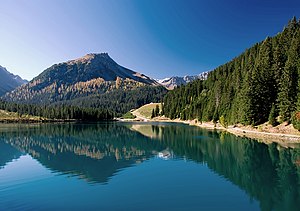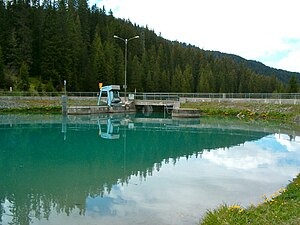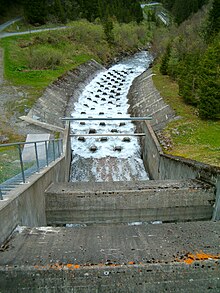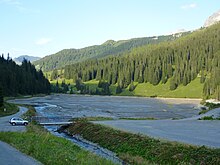Iselsee
| Iselsee | ||
|---|---|---|

|
||
| View over the reservoir to Schafrügg | ||
| Geographical location | Arosa (Schanfigg, Canton of Graubünden, Switzerland) | |
| Tributaries | Plessur , Furggabach, Furggaalpbach | |
| Drain | Plessure | |
| Data | ||
| Coordinates | 772 168 / 183 434 | |
|
|
||
| Altitude above sea level | 1606.3 m above sea level M. | |
| surface | 90,700 m² | |
| volume | 350,000 m³ | |
|
particularities |
Reservoir |
|

|
||
| Schwellwuhr dam | ||
The Arosa reservoir, also known as the Isel or Iselsee reservoir , is a reservoir located at 1606 m in Arosa in the Swiss canton of Graubünden . It is operated by Arosa Energie .
Location and description
The Arosa reservoir has existed since 1897 and is not far from the green lakes in the “Isel” / “Schlugg” area on the Plessur , around 100 meters above sea level below the Untersee . He is dammed by the approximately 12 m high dam Schwellwuhr . In contrast to the Hintere Hütte reservoir of the Arosa Bergbahnen , it is not used for artificial snow- making on the slopes , but for generating electricity .
Flora and fauna
Since the lake came into being, the debris from Plessur and Furggabach has filled a growing delta . Although the reservoir is completely lacking a protective reeds, numerous water and reed birds can be there such as grebes down. The common snipe can also be seen occasionally; a secret, huddling marsh bird with a hoarse, rattling call. In 1967 a mute swan hibernated at the reservoir and only flew away around Easter. For repairs and overhauls, the lake is allowed to run out from time to time, most recently in summer 2011. The plessur takes some of the trout with it, the rest is tried to be caught. Fishers and common ravens sometimes take part in such a catch .
Leisure, tourism, sport
Despite its idyllic location on the Schanfigger Höhenweg and the cross-country ski trail that runs past its south bank, the Arosa reservoir is not open for leisure and sport. However, fishing from the bank is permitted for patented fishermen.
History of Arosa Energie
In 1889, the Arosa spa guest Franz Boerckel submitted a license application to the Arosa council for the construction and operation of a private power station in the Isel, which, however, was not implemented for the time being. After other interested parties had considered the Mühleboden as a possible location for a reservoir in 1894, a committee for the introduction of electrical lighting was formed in Arosa in 1895/96. On September 21, 1896, the shareholders of the consumer company for electrical light, who had subscribed to a total of CHF 72,000 in share capital in sixty-franc titles, were invited to a first meeting at the Hotel Schweizerhof, today's Montana pharmacy. Only two days later, on September 23rd, the company submitted the corresponding application for a license to the municipal council to use the hydropower of the Plessur from the so-called «Schlugg» to the then Arosa municipality border to Langwies . The local authority for its part granted the corporation the license on September 27, 1896, granting the right to take over the work for sale at any time. In addition, the company was obliged to supply the electrical power for all incandescent lamps installed in the new school and community building free of charge and to ensure the best possible street lighting. The community assembly approved the granting of a license on November 29, 1896.
At the beginning of May 1897, construction work on the Schwellwuhr and the machine house in da Brünst below the Blau Rüfi began. The dam wall was originally only 2.50 m high and consisted of concrete and cement walls. The facility was taken over on November 25 of the same year and on Saturday, November 27, 1897, electric lights were on for the first time in Arosa. The residents celebrated the event with a move through the village and a simple dinner at the Hotel Seehof. The construction costs amounted to CHF 234,500. In 1906 and 1924 the wall was raised by a total of 1.12 m to expand the capacity. After the power station became the property of the municipality of Arosa in 1930, a wall 2 m higher was built beneath the old weir in 1938, so that the flooded area of the lake was 29,000 m².
With 268 yes to 132 no votes (participation 83%!), The voters supported the application of the municipal authority on August 30, 1964 to allow the Plessur consortium to use the water power of the Plessur with side streams and to build the Arosa- Lüen power plant . The planned power plant would have used the slope of the Plessur between the Isel reservoir (70 m high dam and 31 million m³ net volume) and the existing Lüen power plant on a gross slope of 890 m. The extensive geological investigations carried out in the area of the Isel then yielded significantly less favorable results than might have been assumed on the basis of earlier investigations. Among other things, it was feared that the realization of such a huge lake, which - ten times larger than the Obersee - would have flooded the entire Isel including a large part of the lower Welschtobel , could cause the Arosa village area to slide. The consortium was forced to refrain from further processing the project.
In September 1968, the lake was dammed by an additional 3.20 meters and the factory in da Brünst built in 1897 was shut down and replaced by the new one located in the valley floor near Litzirüti . The usable amount of water increased from 50,000 m³ to 270,000 m³. In 1982 the storage volume was increased again by increasing the storage capacity to 350,000 m³. The reservoir reached its current size.
In 2011, Arosa Energie carried out extensive overhaul work on the infrastructure of the Litzirüti power plant. Among other things, the inner coating of the pressure line was renewed, which led to a significant improvement in efficiency and an increase in electricity production of around 1 million kilowatt hours (kWh). In the above-average year 2012, the Litzirüti plant produced around 24.8 million kWh and the Lüen power plant, which was taken over by Arosa Energie on October 1, 1983, a total of 45.3 million kWh of electricity.
Arosa Energie has also been operating the newly constructed Sagenbach power plant in Tschiertschen since April 2013 . From a 17 square kilometer catchment area, the plant uses the 518 meter gradient of the Sagenbach - the confluence of Urden - and Farurer Alpbach - between the old Tschiertscher saw and the existing power plant center in Lüen to generate electricity. The annual capacity of the 14 million franc system is around 11 million kilowatt hours, which corresponds to the needs of around 2,500 households. The self-supporting and specially founded pipe bridge over the Plessur is a structurally outstanding element . The plant owner is Kraftwerk Sagenbach AG, founded in April 2011, of which 60% is owned by Axpo Power AG , 30% by Lüen municipal corporation and 10% by Tschiertschen-Praden municipality .
In September 2017, the reservoir was flushed and emptied, as was last done in 2011. The inlet gate was repaired and renovation work was carried out on the slope and pressure pipe for six weeks. A pre-dam built in 1997 ensured that a residual lake remained after the water level had dropped. Some of the fish living in the lake could be retained in it.
literature
- Hans Danuser : Arosa place and field names with inclusion of the Welschtobel and some areas near the border in neighboring communities, self-published Danuser, Arosa 2011, ISBN 3-905342-49-9 , p. 162.
- Hans Danuser: Arosa - as it was then (1850–1907), Vol. 1, self-published by Danuser, Arosa 1997, pp. 118–122.
- Hans Danuser: Arosa - as it was then (1928–1946), vol. 3, self-published by Danuser, Arosa 1999, p. 160 f.
- Hans Danuser: Arosa - as it was then (1962–1978), vol. 5, self-published by Danuser, Arosa 2001, p. 46 ff., 53 f., 98 f.
- Hans Danuser: Arosa - as it was then (1996-2003), vol. 7, self-published by Danuser, Arosa 2004, p. 52.
- Fritz Maron: From mountain farming village to world health resort Arosa . Verlag F. Schuler, Chur 1934, pp. 210-223.
- Ernst Rahm: The Arosa Lakes . Buchdruckerei Arosa, Arosa 1982, p. 9 f.
Web links
- Iselsee on schweizersee.ch
- Information from Arosa Energie
Individual evidence
- ↑ Die Südostschweiz, August 7, 2013, p. 4.
- ↑ Die Südostschweiz, construction report for the new Sagenbach power plant, June 2013.
- ↑ Isla reservoir is being emptied for repair work. (No longer available online.) In: www.suedostschweiz.ch. September 8, 2017, archived from the original on September 24, 2017 ; accessed on September 24, 2017 . Info: The archive link was inserted automatically and has not yet been checked. Please check the original and archive link according to the instructions and then remove this notice.


